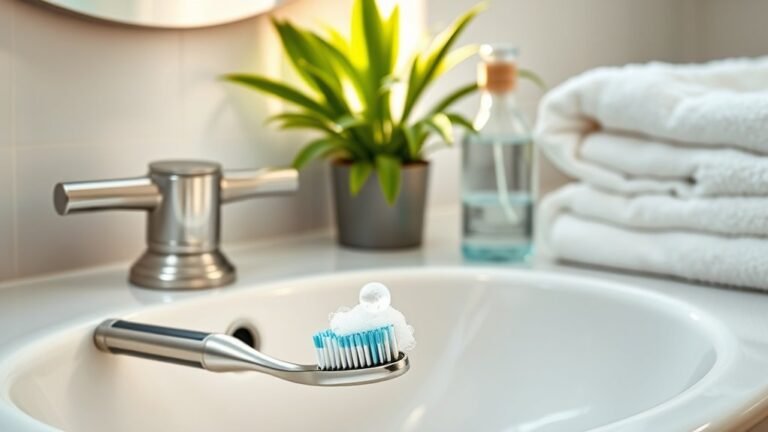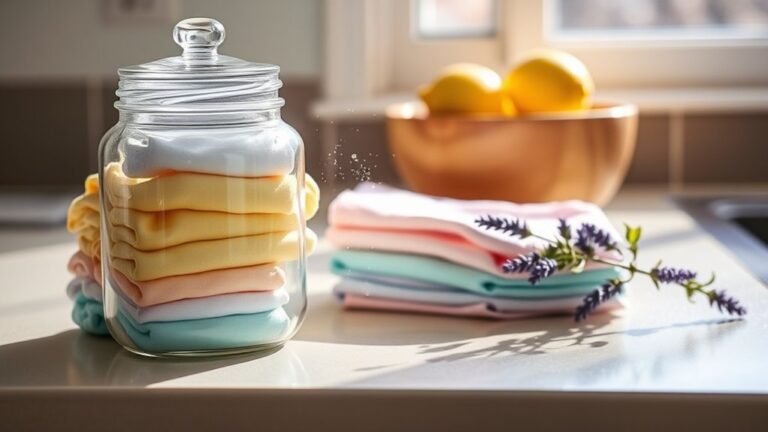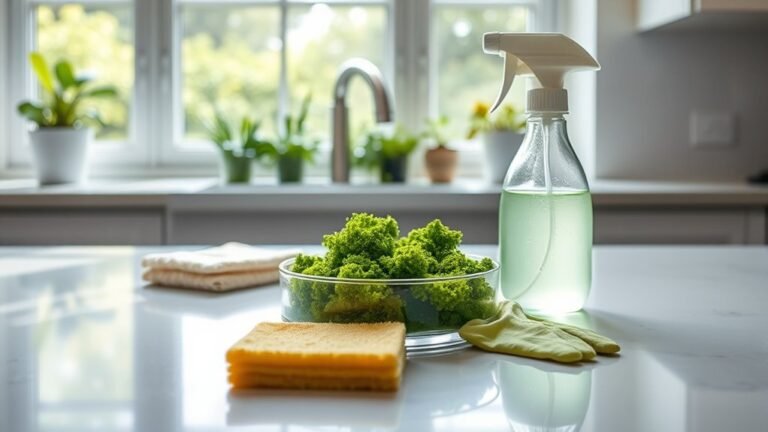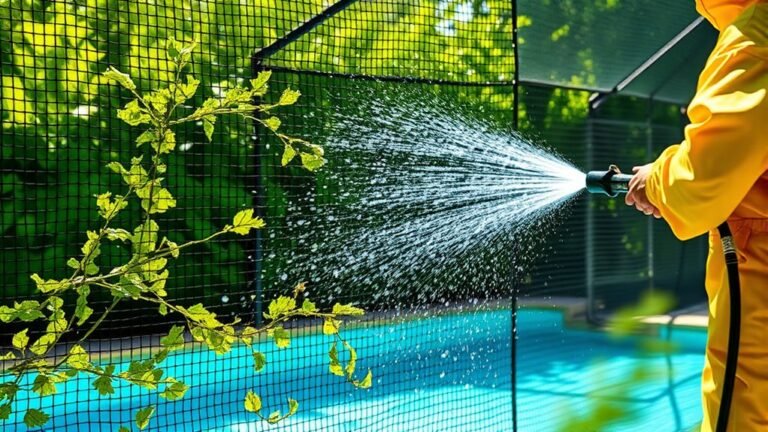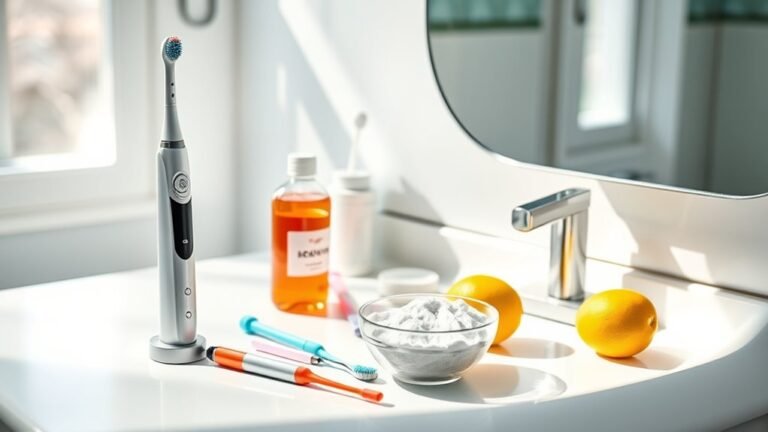How to Clean Your Toothbrush and Keep It Hygienic
To keep your toothbrush hygienic, rinse it thoroughly with running water after each use and store it upright in an open area to air dry. Avoid sharing toothbrushes and keep yours away from the toilet and sink. Sanitize it weekly by soaking in hydrogen peroxide or using a UV sanitizer, and replace it every three months or sooner if bristles wear out. Follow these tips to guarantee a cleaner smile and explore more ways to protect your oral health.
Why It’s Important to Clean Your Toothbrush
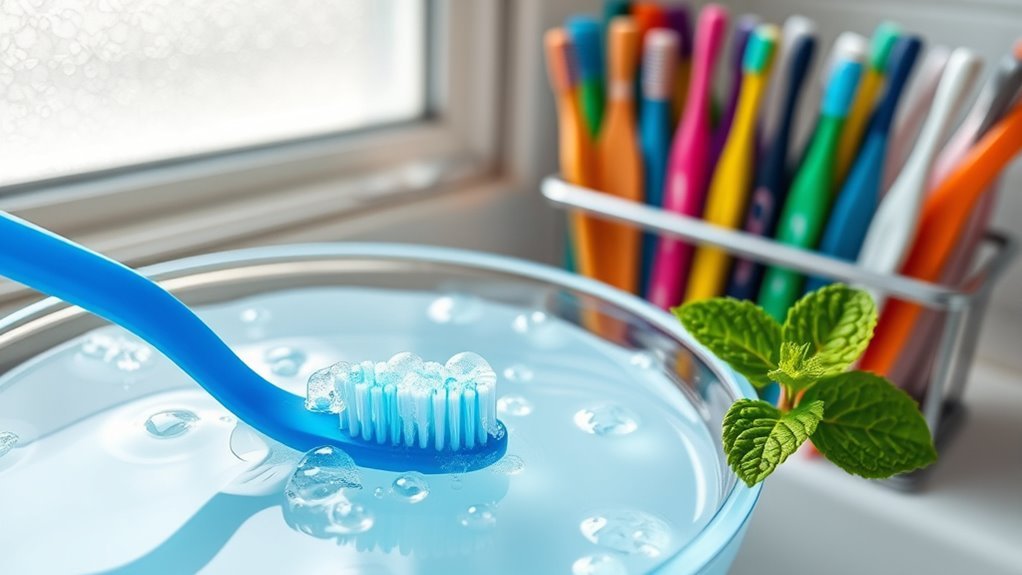
Although you might not think about it often, cleaning your toothbrush is essential because it can harbor harmful bacteria and germs. Those tiny bristles can become a breeding ground for toothbrush bacteria, which may lead to infections or worsen oral health. When you let bacteria accumulate, you’re not just risking your mouth’s cleanliness—you’re compromising your freedom to enjoy a healthy smile. Taking control over your toothbrush hygiene means reducing the chance of illnesses and keeping your oral health in top shape. It’s a small but powerful step toward living free from preventable dental issues. By regularly cleaning your toothbrush, you’re protecting yourself from unseen threats and maintaining the freedom to smile confidently every day.
Daily Practices for Maintaining Toothbrush Hygiene
To keep your toothbrush clean day-to-day, there are a few simple habits you should adopt. First, focus on your brushing technique—rinse your toothbrush thoroughly under running water after each use to remove toothpaste and debris. Avoid sharing toothbrushes to prevent cross-contamination. Next, consider storage solutions carefully: store your toothbrush upright in an open container, allowing it to air dry completely between uses. Avoid closed containers that trap moisture and encourage bacterial growth. Keep your toothbrush away from the toilet or sink to minimize exposure to airborne germs. Finally, replace your toothbrush every three months or sooner if the bristles become frayed. By sticking to these straightforward daily practices, you can maintain your toothbrush’s hygiene and support your overall oral health without feeling restricted.
Effective Methods to Sanitize Your Toothbrush
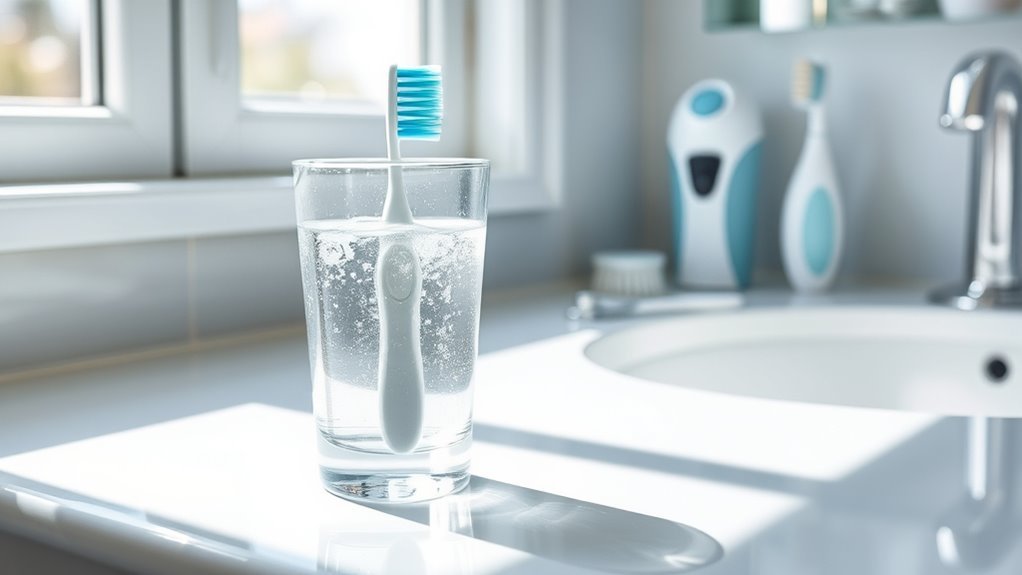
To keep your toothbrush truly clean, you’ll want to use effective sanitizing methods. You can soak it in boiling water or hydrogen peroxide, or even use a UV sanitizer for a quick kill of germs. These techniques help guarantee your brush stays safe and hygienic between uses.
Boiling Water Method
One simple way to sanitize your toothbrush is by using boiling water. Just bring water to its boiling temperature—100°C or 212°F—and carefully dip your toothbrush head for about 3 to 5 seconds. This method kills most germs and bacteria, giving you a fresh start without relying on chemicals. However, keep in mind that not all toothbrush materials handle boiling water well. Plastic handles and nylon bristles usually tolerate brief exposure, but prolonged boiling can warp or weaken them. So, don’t leave your brush submerged for long. This quick, natural technique lets you maintain your toothbrush’s hygiene without hassle, preserving your freedom from harsh cleaning agents while ensuring your oral care tool stays safe and effective.
Hydrogen Peroxide Soak
A simple and effective way to sanitize your toothbrush is by soaking it in hydrogen peroxide. This method taps into hydrogen benefits, as the solution’s powerful oxidizing properties break down bacteria and germs lingering on your bristles. To get the best results, use a peroxide concentration of around 3%, which is safe and widely available. Simply pour enough hydrogen peroxide into a small cup to cover your toothbrush head, and let it soak for about 10 minutes. After soaking, rinse your toothbrush thoroughly with water to remove any residual peroxide. This quick, no-fuss method lets you maintain hygiene without complicated tools, giving you the freedom to keep your oral care routine simple and effective.
UV Sanitizer Use
Soaking your toothbrush in hydrogen peroxide is a straightforward way to kill germs, but if you’re looking for a high-tech option, UV sanitizers offer a powerful alternative. Using UV technology, these devices target bacteria elimination efficiently, giving you peace of mind and freedom from worries about unseen germs. Just place your toothbrush inside, and the sanitizer uses UV light to zap harmful microbes in minutes—no chemicals required.
| Benefit | Convenience | Peace of Mind |
|---|---|---|
| Effective | Easy to use | Reduces illness |
| Chemical-free | Portable | Protects family |
| Quick process | Saves time | Hygienic habit |
| Long-lasting | Minimal effort | Confidence boost |
With UV sanitizer use, you’re embracing a clean, free lifestyle without compromise.
How Often Should You Replace Your Toothbrush?

You should replace your toothbrush every three to four months, or sooner if the bristles become frayed. This timeframe reflects the typical toothbrush lifespan, ensuring your brush remains effective at cleaning without harboring excessive bacteria. Replacement indicators include worn, splayed bristles that don’t reach between teeth properly, or any visible discoloration. If you’ve been sick, swapping your toothbrush might also help prevent reinfection, giving you a fresh start. Don’t hold onto a brush past its prime just to save a few bucks—it’s about keeping your oral hygiene on point and staying in control of your health. Trust your instincts and the signs your toothbrush gives you. Freedom means making smart choices, including knowing when it’s time to upgrade your brush.
Storing Your Toothbrush to Prevent Contamination
Where should you keep your toothbrush to keep it clean and safe? First, choose a toothbrush holder that allows your brush to air dry thoroughly. Avoid closed containers, as they trap moisture and encourage bacteria growth. Place your toothbrush upright in the holder, ensuring it doesn’t touch other brushes to prevent cross-contamination. Keep it away from the toilet and sink to minimize exposure to airborne germs. A good storage tip is to store your toothbrush in a well-ventilated area, letting it dry naturally. By following these simple storage tips, you maintain your toothbrush’s hygiene and protect your freedom to stay healthy without unnecessary restrictions. Remember, where and how you store your toothbrush matters just as much as how often you clean it.
Common Mistakes to Avoid When Cleaning Your Toothbrush
Although cleaning your toothbrush seems straightforward, there are common mistakes people often make that can reduce its effectiveness and hygiene. One big error is neglecting proper toothbrush storage—you want to keep it upright and exposed to air, not trapped in a closed container where bacteria thrive. Another mistake is ignoring cleaning frequency; rinsing your brush briefly after use isn’t enough. You should regularly deep clean it, at least once a week, using warm water or a mouthwash soak. Also, don’t forget to replace your toothbrush every three months or sooner if bristles fray. Avoid sharing toothbrushes or storing multiple brushes too close together to prevent cross-contamination. By dodging these pitfalls, you can maintain your toothbrush’s cleanliness and protect your oral health with freedom and confidence.
Frequently Asked Questions
Can Toothpaste Alone Disinfect My Toothbrush Effectively?
You might think toothpaste alone disinfects your toothbrush, but it doesn’t quite cut it. While toothpaste ingredients help clean your teeth, they aren’t designed to kill all germs on your brush. To truly keep your toothbrush hygienic and extend its lifespan, you’ll want to rinse it thoroughly and occasionally use a disinfecting method, like soaking in mouthwash. That way, you stay fresh and free from unwanted bacteria.
Is It Safe to Share a Toothbrush With Family Members?
You might wonder if toothbrush sharing within family hygiene is harmless, but it’s actually risky. Sharing a toothbrush can transfer bacteria, viruses, and even bloodborne infections between users. While it might seem like a way to save money or space, it compromises your health freedom by increasing illness risk. So, keep your toothbrush personal—your smile and well-being deserve that independence and care. Don’t share; it’s safer that way.
How Does Toothbrush Hygiene Impact Overall Oral Health?
You’ve got to understand that toothbrush hygiene directly affects your overall oral health. If you don’t keep your toothbrush clean, bacterial growth can explode, leading to more oral bacteria in your mouth. This can cause issues like gum disease, bad breath, and tooth decay. By maintaining a clean brush, you’re freeing yourself from these problems and giving your mouth the fresh, healthy environment it deserves. It’s all about taking control of your oral care.
Are Electric Toothbrush Heads Easier to Clean Than Manual Ones?
You want convenience, you want cleanliness—you want freedom from hassle. When it comes to electric toothbrush maintenance versus manual toothbrush care, electric heads are generally easier to clean. Their detachable design lets you rinse and dry quickly, reducing bacteria buildup. Manual brushes require more careful rinsing and storage to stay hygienic. So, if you’re aiming for simplicity and efficiency, electric toothbrush heads might give you the edge you’re looking for.
Can Mouthwash Replace Regular Toothbrush Cleaning Methods?
You might wonder if mouthwash can replace regular toothbrush cleaning methods. While mouthwash efficacy helps reduce some bacteria on your toothbrush, it shouldn’t be your only hygiene alternative. Soaking your brush in mouthwash can’t fully remove debris or germs like rinsing with hot water or using a UV sanitizer can. For true freedom in oral care, combine mouthwash with regular cleaning to keep your toothbrush hygienic and effective.

